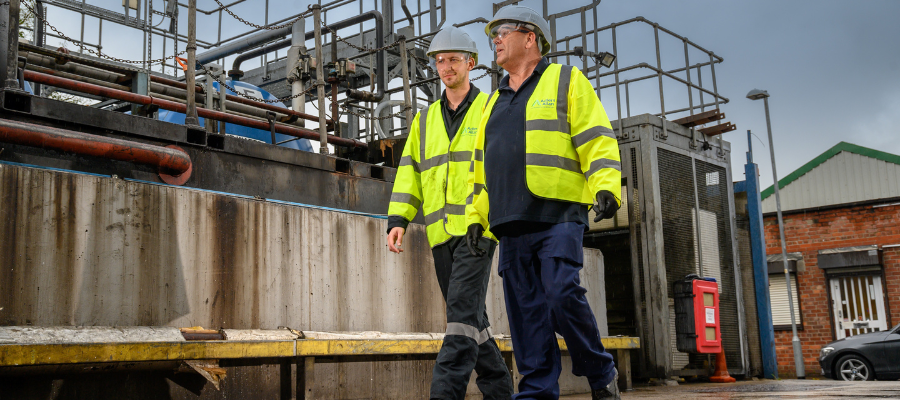🕒 Article read time: 2 minutes
Managing critical infrastructure and preparing for the energy future
Sponsored content

Transport currently represents roughly a quarter of global CO2 emissions from energy, of which 29.4% comes from trucks carrying freight.
Fuelled by the government’s Transport Decarbonisation Plan, the industry is committed to reaching net zero by 2050.
Road transport and logistics organisations are currently at a crossroads, deciding whether to move to the erratic hydrotreated vegetable oil (HVO) market or electric and hydrogen fuelling, which requires higher upfront costs. While road operators plan their next steps, they also face the challenges of maintaining critical assets and reducing risks to the environment, their business, and reputation.
Your primary (tank), secondary (bund), and tertiary (separator) containment systems are your first, second, and third line of defence against environmental pollution. Regular asset maintenance is essential to keep all pollution prevention equipment working at optimum efficiency, safeguarding transport and logistics businesses handling and storing oil or other hazardous materials.
Shirley Miles, Head of Environmental Protection at Adler and Allan, discusses how partnering with a trusted environmental protection provider can help you implement the standards correctly to ensure your critical infrastructure remains compliant.
EVALUATING INDUSTRY AWARENESS
In May and June 2022, Adler and Allan, along with Logistics UK, ran a series of polls on social media and at the Multimodal exhibition.
The survey explored asset maintenance regimes and knowledge of BS EN 858-2:2003 Separator systems for light liquids, the current standard by which separators/interceptors should be operated and maintained.
- 74% knew the condition of their critical assets, such as fuel tanks, bunds, and separators, and had regular maintenance schedules for each.
- 56% understood the maintenance regime required by BS EN 858-2:2003 for separators.
- Just 40% followed the requirement to have automatic warning devices fitted to their separators.
- Similarly, only 40% adhered to the guideline to perform a five-yearly integrity inspection on their separators.
PRACTICAL PLANS FOR PRIMARY, SECONDARY, AND TERTIARY CONTAINMENT
A pollution incident caused by a poorly maintained asset or inadequate containment is a strict liability offence. Failure to adhere to standards is a key factor in considering enforcement action, with potential fines of up to 100% of an organisation's pre-tax profits.
A robust asset maintenance programme provides information for service log scrutiny during routine inspections or following an incident. It is also an essential part of pollution prevention.
PRIMARY CONTAINMENT (TANKS)
Primary containment is the most important means of avoiding major pollution events. It includes equipment in direct contact with stored substances, such as tanks, vessels, pipework, valves, and pumps, as well as equipment that prevents the loss of contaminants under abnormal conditions.
In addition to weekly visual checks, you should use a qualified technician to perform a detailed annual inspection and service of your storage facilities. Road operators should also commit to preventative measures, including:
- Tank audits and inspections to test for leaks and structural concerns
- NDT testing against API standards to evaluate asset quality without destroying serviceability
- Tank lining to protect against deterioration and resist water and chemicals
- Tank cleaning to remove harmful build-up and contamination
SECONDARY CONTAINMENT (BUNDS)
Regular inspection and cleaning are key to an effective bund maintenance programme, ensuring your secondary containment system is structurally sound and free of contaminants. This should include:
- Bund audits to assess performance and identify defects before they compromise integrity
- Bund cleaning to remove leaked tank contents, even in hard-to-access spaces
- Bund lining to protect against deterioration, degradation, and structural weakness.
TERTIARY CONTAINMENT (SEPARATORS)
Separators form an integral part of a tertiary containment strategy as they are designed to trap harmful light liquids before they enter the surrounding area. A preventative maintenance plan should cover:
- A separator alarm system that monitors oil, silt, and liquid levels, ensuring assets are operating correctly and preventing pollutants
- Six-monthly inspections by an experienced environmental expert to check levels and functionality of key components
- Five-yearly integrity audits that check for fractures, displacements, and groundwater ingress
Proactive risk reduction services and tailored, specialist support can significantly reduce the risk of an environmental emergency – and the penalties imposed following a pollution event.
Decarbonisation is a defining moment for the road transport industry. Ensuring your critical assets remain compliant helps you rise to the net zero challenge and shape a sustainable business strategy, through the energy transition and beyond.
*Download the whitepaper on managing critical infrastructure and preparing for the energy future from Adler and Allan
Published On: 14/07/2022 16:00:34

Comments Section
If you are a Logistics UK member login to add comments.